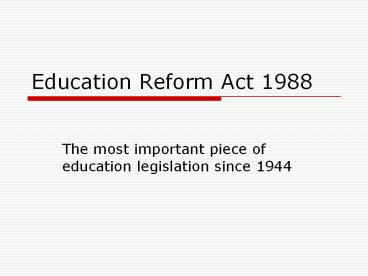Education%20Reform%20Act%201988 - PowerPoint PPT Presentation
Title:
Education%20Reform%20Act%201988
Description:
Education Reform Act 1988. The most important piece of education legislation since 1944 ... annually in league tables (along with GCSE/A levels and truancy statistics) ... – PowerPoint PPT presentation
Number of Views:72
Avg rating:3.0/5.0
Title: Education%20Reform%20Act%201988
1
Education Reform Act 1988
- The most important piece of education legislation
since 1944
2
There are 6 main features
- A National Curriculum
- National Tests at 7, 11 and 14
- Local Management of school budgets (LMS)
- Opting Out (Grant Maintained schools)
- City Technology Colleges
- Ofsted a new inspection regime for schools
3
The National Curriculum
- A government sanctioned common curriculum for
pupils aged 5 16. - Shifted responsibility for what was to be taught
away from teachers to central government. - Three core and seven foundation subjects
- Previously teachers worked out schemes of work
they deemed appropriate for their pupils.
4
National Tests
- Compulsory National tests (SATS) were introduced
at 7, 11 and 14 - Results published annually in league tables
(along with GCSE/A levels and truancy
statistics). - Schools can now be compared directly in terms of
this data - Previously pupil progress was tracked by teacher
assessments
5
Local Management of Schools
- Management responsibility for school budgets
taken away from LEAs and given to individual
schools (Head Teachers). - Much greater flexibility and responsibility now
on Heads
6
Grant Maintained Schools
- State schools were given the option under the ERA
to opt out completely from LEA control. - If the majority of parents voted for such a step
newly formed GM schools had complete control over
their budgets and how the school was run
7
City Technology Colleges (CTCs)
- A new type of school was set up in the inner
cities - CTCs specialising in technology, the arts, maths
and science set up in inner city areas - CTCs are independent of LEA and were intended to
be financed by local industry
8
Ofsted
- The Office for Standards in Education (Ofsted)
was set up. - Rigorous school inspections every 6 years
- Emphasis on inspection rather than support.
- Aggressive system of naming and shaming and
placing into special measures for failing
schools
9
Task
- For the 6 Key areas of Reform think of arguments
in favour and against each item - Key Question Has the ERA improved the quality of
education in the UK? - Back to Education Lessons Menu































